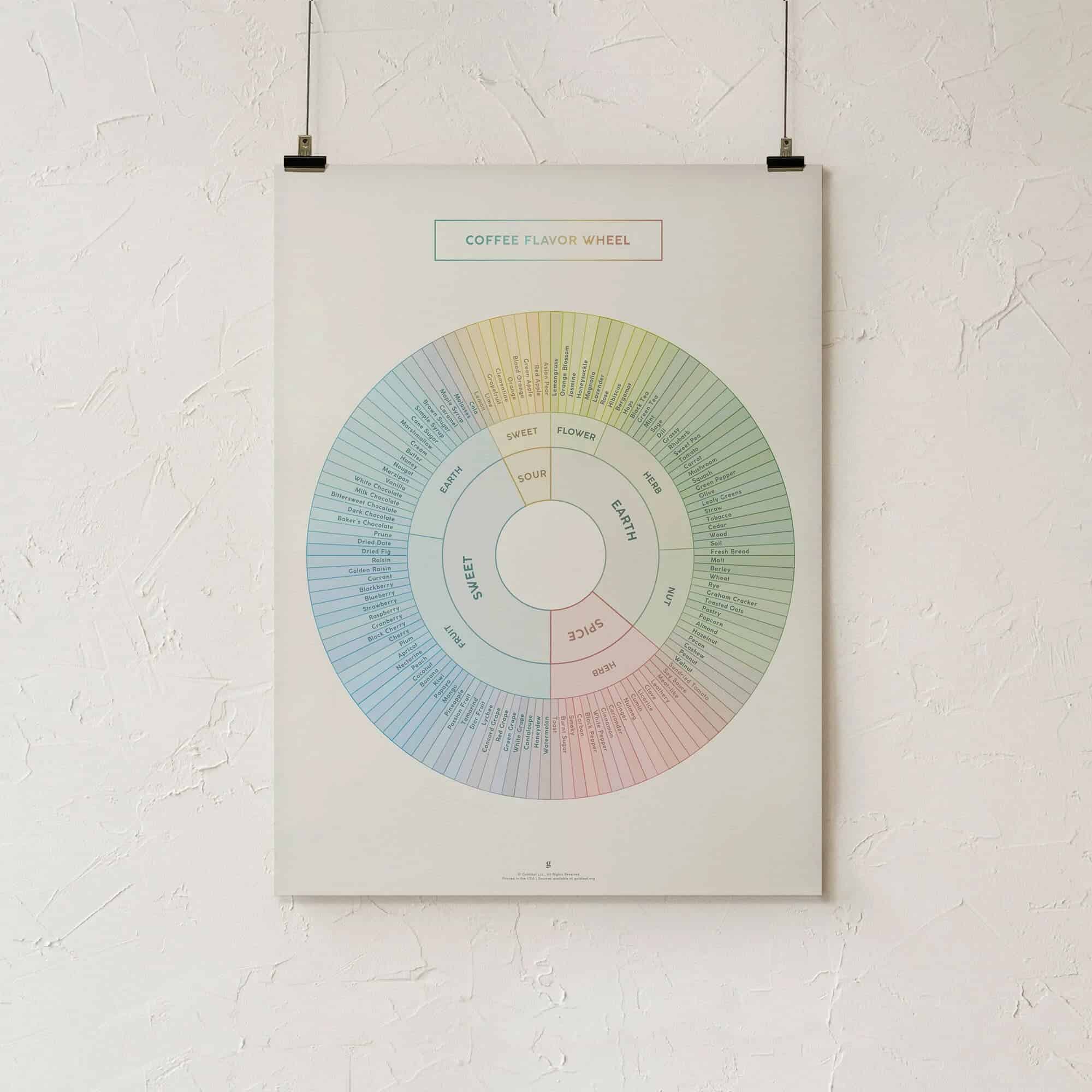Coffee Flavor Wheel: How To Read It And Taste Your Cup
Coffee’s a unique hobby.
It’s an experience and a pretty sophisticated topic spanning geography, culture, history, biology, even chemistry.
If you’re a coffee nerd newbie, you may have come across the colorful coffee taster’s flavor wheel, which looks an awful lot like a toy for coffee nerds. (It is.)
What is it? And how do you use it like a pro?
I’m embarrassed to say I haven’t used it before, but it’s never too late to learn. Let’s walk through the coffee flavor wheel together, so we can cup with the best of them.
What Is The Coffee Flavor Wheel?
The coffee taster’s flavor wheel is a fun tool to help you taste, describe, and analyze coffee.
Published in 1995 by the Specialty Coffee Association of America (SCA) and the World Coffee Research (WCR) organization, it is the industry standard for coffee professionals in describing the flavors and aromas of coffee.
How Professional Tasters Evaluate Coffee
The flavor wheel has 169 attributes (names) for all the possible flavors in coffee.
These attributes come from the World Coffee Research’s sensory lexicon. Developed by their sensory scientists, the lexicon has a standardized set of flavors/attributes that can be used to evaluate coffees in research.
The official, entire continuum of tastes and smells possible in coffee are included. That means everything from basic tastes — what you can sense with just your taste buds — to pure aromatics — sensed with only your nose.
Of course, each attribute is also a great way to describe coffee for industry and personal use, not just in research. Professional tasters (“cuppers”) and even amateur coffee lovers can use the coffee taster’s flavor wheel to distinguish and describe different coffee varieties.
With the coffee taster’s flavor wheel, the taster works from general flavor categories and moves farther outward toward specific descriptors. A ‘sour’ coffee becomes ‘sweet,’ with notes of ‘clementine.’
Why Use It
The coffee flavor wheel is the periodic table of coffee tasting.
Beyond “nutty,” “acidic,” etc., the coffee taster’s flavor wheel has words like sage, marshmallow, lychee, or baker’s chocolate, all taken from the World Coffee Research’s sensory lexicon.
You can nerd out over aroma and flavor profiles as you compare brews, especially when you’re teasing out the differences between one roaster’s nutty Honduran medium roast, and another’s.
Your taste buds can distinguish between brews, but sometimes your brain needs suggestions to land on “magnolia” to describe an herb-like coffee profile.
Whether you’re professionally cupping or sampling for fun, the flavor wheel can help any struggling taster find a more sophisticated and accurate description.
Because let’s be honest, when you’re new to coffee, your vocabulary is pretty much limited to words like “good,” “strong,” or “icky.”
How To Use The Coffee Tasting Wheel
Using the coffee tasting wheel is simple. You just start at the center and work your way outward.
It’s designed to move from the most general taste descriptors, and fans out into more specific tastes and aromas, the kind you might have trouble identifying on your own.
For an example, I’ll walk you through identifying the attributes of the cup I’m drinking right now. But it’s best to try using the flavor wheel with something you can actually taste. Consider this your excuse to make another cup.
Start In The Center
The wheel’s design encourages you to start at the center. As you can see, the two inner rings have broad categories to get you going.
The first — sweet, sour, earth, and spice — is easy enough. You don’t need to be a coffee expert to tease this one out.
Take a sip of coffee to get started. Then identify which of the innermost categories best describes the flavor or smell you’re getting. (In fact, it’s not a bad idea to smell your drink, too.)
My decaf espresso is somewhere between sour and earthy. Since this is less sour than many espressos I’ve tried, we’ll say it’s more of an ‘earth.’
Work Your Way Out
From there, we work outward to the middle ring.
Looking at the flavor wheel, you’ll see ‘earth’ tastes can be described as floral, herb-like, or nutty. My drink is slightly more of an ‘herb’ than a ‘flower.’
The outer ring has the most specific words. These are the attributes you might see in the description or notes of a specialty roast. (Now you know how coffee professionals come up with “marzipan” or “dill” for a coffee variety.)
Reading the ‘herb’ options, I started closer to the ‘flower’ end of the spectrum, since I had trouble deciding. I finally landed on ‘bergamot’ as a primary note.
If you’re stuck, you can read every attribute in the category to help you decide if you’re struggling. Because it’s a spectrum, you can also work your way up or down based on the closely related flavors you recognize, but which aren’t quite right.
For example, you may not have tamarinds in your region, but if your taste buds are telling you that fruity Ethiopian blend is a bit herbier than passion fruit, you may settle on tamarind as an attribute anyway.
Take Note
You don’t have to stop there.
Although it might be challenging for a new taster, you can use the coffee taster’s flavor wheel to tease out a few of the stronger notes you’re getting, not just the main flavor.
That goes for aroma, too, since our senses of smell and taste are strongly connected and both actually play a role in creating flavors.
It’s also interesting to note which flavors aren’t as closely related. You’ll notice not all the fruits are side by side. So while you might expect cherry to be strongly connected to other berries, it’s more closely related to plum.
As a taster, you can use this tool to help you identify coffees you’ll like better as you become more familiar with the attributes out there.
It’s also interesting to note that the colors for each attribute matter. It may take some time to work out all the color associations, but if one sip says “red fruit” you can turn to the red colored attributes and identify ‘cherry’ faster.
Note: Some wheels vary on the precise colors used for each subcategory (this seems to be a matter of aesthetics). Although, most or all of the attribute names will likely still match the World Coffee Research lexicon names.
Understand The Language
You can work with the Specialty Coffee Association flavor wheel as is, but it makes more sense if you have the World Coffee Research sensory lexicon open, too.
In the WCR’s lexicon, each attribute has flavor references. An ‘orange’ attribute has “citric, sweet, floral, slightly sour” flavor references, which might go so far as “bitter, peely, and astringent.”
The lexicon also opens with a guide to using it more scientifically, if you’re interested in amateur coffee research.
Frequently Asked Questions
How do you read a flavored wheel?
In most flavor wheels, the tiers work outward. To read it, the taster will start at the center and work out by what they taste and smell.
The inner taste names are broader. Descriptors get more specific as you move outward.
Which coffee flavor is best?
People like what they like. Everyone has a preferred flavor range and none is inherently “better” for any other reason.
The best you can do is identify your favorite notes as a taster and gauge from there. You may find you like a fruity aroma or sour wine-like flavors in coffee.
If you use a flavor wheel to get familiar with the broad variety out there, you can narrow down your “best” flavors and stick to coffees with similar notes.


